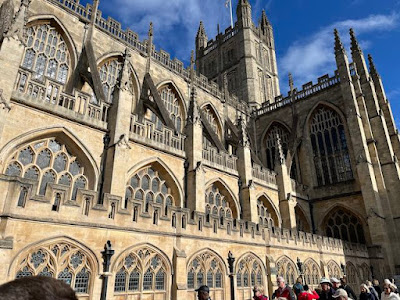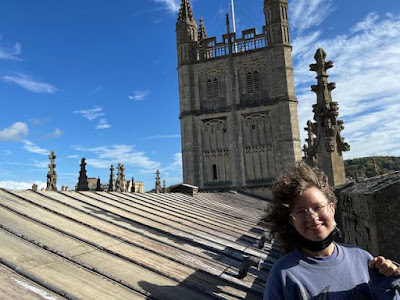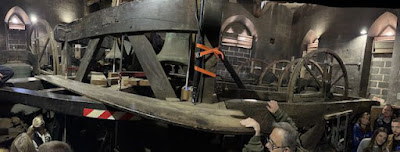We arrived in Bath around noon and managed to find a parking place near the center city and made our way to the Bath Abbey. It's a very pretty building and I kept taking pictures each day from every angle as we walked around.
The square in front of the Abbey was very crowded. The entrance to the Baths is directly to the right.
The upper windows are all clear and let in a ton of light. The fan vault supports are beautiful.
As with every church I visit, if there is a stair to be climbed, I'm there! We got to climb up to the top of the bell tower. It required a transit across the roof.
A few of the great bath from the church roof.


This is looking at the fan arches on the ceiling from above. The stones all reach up to a center point where all the forces are held in place by a single keystone (in the center of the picture below).

The bell tower has 10 bells. Change ringers ring from this room by pulling these ropes. They gradually rock the bells until they are suspended upside down in their frames and then when they tug, the bell swings 360, rings once and then stops facing up again. Ringing in this method uses the large clapper in the bell.
Each bell also has a smaller hammer that hits the lip of the bell. These can be played by tugging on this second set of ropes (kind of like plucking a harp string)
The final mechanism is the chimes connected to the clock. Every quarter hour the bells chime. This is controlled by the mechanism in the box which is connected to a small third set of hammers that hit the bells.
When the ringers go through a whole set of ringing patterns, it is called a peal. The significant ones that they complete without an error are denoted by plaques on the wall. They are often done for major occasions, such as the wedding of Princess Elizabeth and Prince Philip (above) or the Diamond jubilee (below)
This is the inside of the clock. It is only on the north-facing side of the tower (it was too expensive to have more than one clock face). The guide very pointedly told us not to touch the mechanism at all. A little girl once pulled herself up by grabbing part of the works and broke the clock. It took several months to be repaired.
Here is the clock from the outside.
The pull ropes will rock the wheel mechanisms 360 degrees to get the bells facing up.
The largest bell is named "Ethel" and weighs approximately 1 ton. The bells were restored in 1957. They can be lowered down from the tower through the floor/ceiling. This takes a ton of work as is rarely done.
If you look closely you can see one of the additional hammer mallets that sound the bell.
The red metal piece attached to the rope is part of the chime mechanism.
A view from the top of the tower.
The story of Jesus' life told in 56 separate panels of stained glass.
1991 restoration project of the Abbey included a new organ. It's beautiful.

The Abbey floor is made up of 891 flat grave stones. They were recently removed for restoration and reset.
There are 635 memorials around the walls of the Abbey. It reminds me a lot of Westminster Abbey because of all of the memorials on walls and floor.
























No comments:
Post a Comment